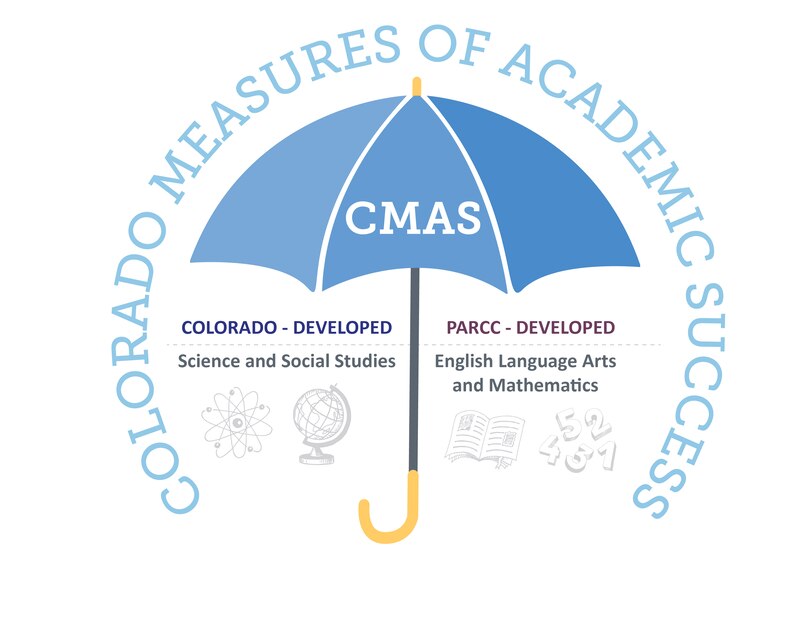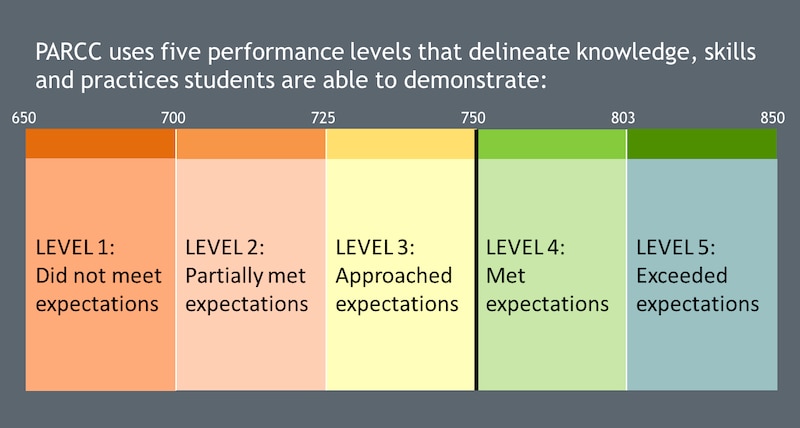On Thursday morning, the state will release the first batch of scores from the PARCC English and math tests Colorado students took this past spring.
Confused about what that means and why it matters?
We’re here to help …
What are the PARCC tests?
PARCC tests are a new set of annual English and math tests that were given to Colorado students for the first time this past spring. Most students took the tests online.
What does PARCC stand for?
PARCC stands for the Partnership for Assessment of Readiness for College and Careers. The partnership part refers to the fact that several states, including Colorado, banded together to develop the tests. In the 2014-15 school year, students in 11 states plus the District of Columbia took them. New York ran a pilot program but didn’t test all students.
What happened to the old tests?
They’re no longer relevant because Colorado changed its learning goals for students.
In 2010, the Colorado State Board of Education adopted what are known as the Common Core Standards. The standards are a set of expectations for what students should know in English and math at the end of each grade. Colorado is one of 43 states, along with the District of Columbia, that use them.
The standards were in effect in all Colorado schools by the 2013-14 school year. Because they include new learning goals for each grade, Colorado needed new tests to measure whether kids are meeting those goals. Hence, the PARCC tests.
Before PARCC, Colorado had tests called CSAP, or Colorado Student Assessment Program, and then TCAP, or Transitional Colorado Assessment Program. The TCAP tests were given to students in 2012, 2013 and 2014 as Colorado transitioned to the Common Core Standards.
So many acronyms.
We know. And here’s another one: CMAS, or Colorado Measures of Academic Success.
CMAS is the acronym for the entire bundle of standardized tests that Colorado students now take. The English and math PARCC tests are just one part of CMAS. The other part is a set of science and social studies tests that were developed by Colorado alone. Those tests were given to students for the first time in the spring of 2014 and again in the spring of 2015.
Here’s a handy umbrella graphic from the Colorado Department of Education that explains the test structure:

But the scores this week are just for the English and math tests, right?
Right. The scores for the science and social studies tests already came out. Scoring the English and math tests took longer because they’re new this year. In the future, the state hopes to release the scores before the start of the next school year. So if students take the tests in the spring, the results will hopefully be available by the summer.
How are the PARCC tests different than past tests?
The PARCC tests are supposed to be harder. In addition to measuring whether students know the basics, they’re designed to test skills such as critical thinking and problem solving.
The English tests include both reading and writing, as opposed to the way things used to be, with separate tests for each. The questions are different, too. In the past, students might have been given a word and asked to pick a synonym for that word from a list of five choices. The PARCC tests still ask about the meaning of words but in the context of a story, such as in this example from the PARCC website: “What is the meaning of the word dictate as used in paragraph 23?”
The math questions are also more complex. They tend to involve multiple steps that require students to show that they understand the concepts, not just that they know the right answer.
Read some more sample questions here.
Which students took the PARCC tests?
Colorado students in grades three through 11 were tested in English. Math tests were given to students starting in grade three and ending with students who’d completed Algebra II or Integrated Math III. Integrated math is a type of curriculum that blends elements of Algebra I, Geometry and Algebra II over the course of three years. Instead of taking Algebra I one year, Geometry the next and Algebra II the next, students take Integrated Math I, II and III.
The exact number of students who took the PARCC tests won’t be released until Thursday. But the state Department of Education says about 1 million tests were given.
Next year, that number will be lower. In May, state lawmakers responded to concerns from parents, teachers and others about too much testing by passing a bill to limit it. Starting next year, only students in grades three through nine will take the English and math PARCC tests. The high school tests will be replaced with college prep and college entrance exams, such as the ACT, although the state hasn’t decided which exams it will use.
Is it the same in other states that are part of PARCC?
Not necessarily. Testing requirements vary from state to state. At a minimum, the federal government requires states to test students in grades three through eight in English and math and once in high school if the states want federal money for things such as supporting students with disabilities and supporting low-income students (and most states do).
But, wait. Can’t parents opt their kids out of PARCC?
Yes. That same bill that state lawmakers passed in May says that parents may excuse their children from taking one or more of the tests. And districts are prohibited from imposing negative consequences on students who opt out.
Which scores will the state be releasing this week?
Statewide test results will be made public at or shortly before 10 a.m. Thursday. The results will include the number of students in each grade who took the tests and how well they did. For instance, the results will show how many third graders met expectations in math and how many met expectations in English. (For more on what that means, keep reading.)
The scores also will be broken down by various subgroups, such as students’ race and ethnicity; whether they qualify for free and reduced-price lunch, an indicator of poverty; and whether they’re English language learners. So it will be possible to compare how several different subgroups — white, black and Hispanic third-graders, for example — did on the tests.
In addition, the state will release the number of students who opted out.
The results will not include scores for individual school districts, schools or students. Those scores won’t be available until next month because the state is still awaiting and validating the final data. Once the state releases that data, it will be up to the districts and schools to provide parents with individual student score reports. The reports will look something like this.
How are the tests scored?
Each test is worth between 650 and 850 points. Students are given a raw score and then placed into one of five “performance levels” based on that score. Here’s the breakdown:
Level 1 (score of 650 – 699) = Did not meet expectations
Level 2 (score of 700 – 724) = Partially met expectations
Level 3 (score of 725 – 749) = Approached expectations
Level 4 (score of approximately 750 – 800) = Met expectations
Level 5 (score of approximately 800 – 850) = Exceeded expectations
The last two levels are fuzzy because the scores vary from test to test. For example, on the third-grade English test, a score in the range of 810 – 850 would put a student in Level 5. On the eighth-grade math test, the score range for Level 5 is 801 – 850.
Only students in levels 4 and 5 are considered to be on track to enter the next grade — or for high school students, ready for college or a career.
This Colorado Department of Education chart shows the five levels.

Who set the performance levels?
Panels of teachers, college faculty members and education experts from all of the states that belong to PARCC worked together to determine which scores should correspond to which levels. In August and September, the levels were approved by the PARCC governing board, which is made up of state education chiefs, including Colorado’s commissioner. Those levels needed to be set before the tests could be scored and the results could be released.
Here’s an essay by a Colorado teacher who helped build the PARCC math tests.
How will the scores be used?
This year’s PARCC scores will be used as a baseline to measure future academic growth. Starting next year, districts, schools and teachers will be able to compare scores from year to year to see if the number of students meeting PARCC’s expectations is growing or shrinking — which can help determine whether kids are learning and educators are on the right track.
But it’s not possible to draw those conclusions yet. As such, state lawmakers created a one-year “accountability pause.” Teachers, schools and districts won’t be held accountable for this year’s scores, and the scores won’t be used in evaluations or accreditation decisions.
However, it will be possible to compare Colorado’s baseline scores to the baseline scores of other PARCC states. Those state-to-state comparisons, which provide further context, are considered by some to be one of the advantages of the PARCC system.
So are the other states releasing their scores this week, too?
No. Each state is releasing its scores on its own timeline.
Several states, including Illinois and Ohio, have already released partial or preliminary data. New Jersey and New Mexico are among the states that have released more robust results.
Isn’t it true that some people don’t like PARCC?
Absolutely. The tests have been criticized for being too expensive and taking up too much school time. Other critics don’t like that PARCC is a multi-state consortium that receives federal funding. However, attempts by state lawmakers to withdraw Colorado from PARCC have failed.
When will students take PARCC tests again?
Colorado students are scheduled to take the PARCC tests again in April. That month, some students will also take the state-developed science and social studies tests, and high schoolers will take college prep and entrance exams. In response to backlash about extensive testing time, the PARCC tests will be 90 minutes shorter than they were this past spring.

